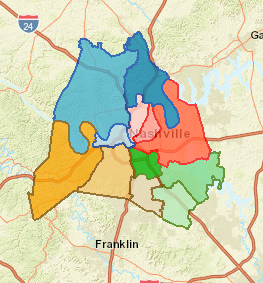
Stuck in Sinking Sand on the Pathway to Graduation
Following Nashville Students’ Educational Journeys
Through the release of our Metro Nashville Public Schools (MNPS) Cluster Profiles, the Scarlett Family Foundation hoped to share data in a clear, concise format, and use this information to help tackle some of our city’s most pressing education questions, including: what happens to proficiency levels as students progress through their zoned schools?
In our last blog post, we zeroed in on another critical question: are Nashville students graduating ready for college or career? And we drew the conclusion, based on the data available to us, that an overwhelming majority of students are not graduating ready for their next step. But is this exclusively a high school problem? In order to paint a full picture of our student achievement deficits, we decided to take a deeper look into the pathway MNPS students will take toward graduation, beginning in their earliest school-going years.
In schooling, grades act as stepping stones, connecting one level of academic understanding to the next. Each grade creates different opportunities for students to be curious, explore their world, and leave prepared for the next step awaiting them. But when we look at cluster-level data, we find that student access to quality public education, and the opportunities found therein, look drastically different depending on where a student lives.
In too many neighborhoods, the pathway to graduation is like sinking sand, pulling students deeper into a broken system of low-performing schools— at every consecutive stage of their education.
All students deserve easy access to high-quality, public schools. But in Nashville, this is not a reality.
To see how starkly different a student’s school journey will look based upon his or her address, let’s compare two school clusters: Hillwood and Maplewood.
Elementary School
If a student lives in the Hillwood cluster, she will be zoned to attend one of four elementary schools. Two of these are Reward schools (ranking in the top 5% of all Tennessee schools), and another far exceeds state average proficiency levels for both English Language Arts and Math (58% and 50% achieving proficiency, respectively). On average, less than 1% of the elementary school students in this cluster have been suspended, only 11% are chronically absent (missing 10% of the school year, or 18 days), and teachers choose to remain in their positions by a rate of 92%. Looking at these metrics alone, it appears that families in this neighborhood have access to elementary schools able to provide their children a high-quality education.
In the Maplewood cluster, a student will also be zoned to attend one of four elementary schools, depending on where exactly he lives. One of these schools is a Reward school – but one is a Priority school, ranking in the bottom 5% of all schools in Tennessee. Only 17% of all elementary students in the Maplewood cluster are proficient in English Language Arts, and 15% in Math. On average, close to 4% of elementary students are suspended annually, 23% are chronically absent, and almost 16% of teachers are new to the job each year.
Let’s imagine that a family in the Maplewood cluster is considering enrolling their student at Tom Joy Elementary. A Priority school, only 5% of Tom Joy’s 421 students are proficient in English Language Arts, and the rate is even lower for Math. Unless this family has the ability to enroll their child in a charter or private school, their only elementary school option is a school that fails to bring 95% of its students to proficiency. This is a disservice to the family and to the child.
The metrics presented in our Cluster profiles make clear that a scenario like this is the reality for countless Nashville families, and illustrate that even in elementary school, a majority of MNPS students are already being left behind.
Middle School
The degree to which student achievement lags behind grade level standards only grows from elementary to middle school.
The Maplewood cluster is home to two zoned middle schools – and both rank in the bottom 5% of schools statewide. Across the cluster, enrollment drops from elementary to middle school, and nearly 17% of students will either be suspended or chronically absent from school. The two-year rate of educators who do not return to teach in these schools is 20% . Taken together, these challenges affect the ability of teachers to teach and students to learn: only 6% of middle school students in the Maplewood cluster are proficient in English Language Arts, and less than 5% are proficient in Math.
Hillwood also has two middle schools, but in this case, both exceed the MNPS average for proficiency in English Language Arts and Math. Proficiency rates for students in English Language Arts is 29, and 26% in Math. However, like the Maplewood cluster, enrollment drops from elementary to middle, and the percentage of students who are suspended or chronically absent nearly doubles.
If we compare the two clusters, Hillwood’s middle schools are performing well – but let’s flip some numbers. If roughly 30% of students are proficient in ELA or Math, that means at least 70% of Hillwood students are not achieving proficiency. Imagine the effect this will have on our students as they enter high school, and eventually a college classroom or professional workplace.
As we comb through these numbers, a trend emerges. In all clusters, academic achievement sinks as we follow the pathway of elementary to middle to high school. It seems that students progress from one grade to the next without gaining the academic knowledge they will need to flourish in the future.
High School
As students in the Hillwood cluster transition from middle to high school, even more of them will miss at least 10% of all school days— now, one in five students is chronically absent. Consequently, English and Math proficiency numbers also decline. Although the vast majority of students in this cluster will graduate, a much smaller number will score a 21 or higher on the ACT, indicating that they should be considered college and career ready — only one in four, or about 265 students.
In the Maplewood cluster, we see an even more significant spike in empty seats during the school day, with 42% of students chronically missing school. The number of students “On Track” dips below 5% in both English or Math, and only around 41 students are considered college or career ready upon graduation. Still, just as in the case of Hillwood High School, most of these students will receive a high school diploma.
What’s Next?
Unless dramatic improvement is made, a student in the Maplewood cluster will attend a school ranking in the bottom five percent statewide for every year of their education.
For a student in the Hillwood cluster, the academic experience is likely to be better— but far from exceptional. From elementary to high school, the percentage of students that are considered “On Track” continues to slide lower at each step, until only 17% (ELA) and 7.2% Math) of students are learning what they need.
Incredibly, the graduation rates between these two high schools, Hillwood (81%) and Maplewood (79%), are almost the same— with only a 2% difference.
These numbers demand a city-wide conversation. Let’s decide, finally, that zip code will not be destiny for Nashville students.
It’s time for all members of our community to band together and push for transformative change. We must create a system that allows all high school graduates to succeed after graduation, no matter which post-grad pathway they choose. And when we say all students, we mean all— from Hillwood to Maplewood.
Read more about ways you can get involved and make change here.
Tags: MNPS Cluster Profiles

The Next Step: Students Graduate, But Are Not Ready
By Tara Scarlett
A shorter version of this piece originally ran in the Tennessean. https://www.tennessean.com/story/opinion/2019/04/26/nashville-students-graduating-high-school-unprepared/3554911002/
Next month, Metro Nashville Public Schools (MNPS) will celebrate another graduating class with pomp and circumstance. They will bestow upon our high school seniors a diploma, a mutually understood signal that these students are ready to forge ahead to college or the workforce.
In reality, most of them are not.
The 2017-2018 Tennessee Department of Education report card shows that 80% of our students graduated high school on time. However, this same report also shows that 3 out of 4 MNPS students did not score a 21 or higher on the ACT, which is the state’s marker for– and a widely accepted indicator of– college and career readiness.
The situation becomes even more dire when we realize that the state assessment indicates 89% of our high school students are not proficient in grade level math; and 81% are not proficient in grade level English Language Arts.
These averages only scratch the surface. When we dive deeper into the data on specific MNPS high schools, as the Scarlett Family Foundation has done, we see rates of chronic absenteeism (students missing more than 10 days) as high as 30, 40, even 47 percent. We see that almost every student zoned for Whites Creek High will attend a priority school (a school measuring in the bottom 5 percent statewide for student growth) for every year of their education. And we find that in eight out of the twelve traditional MNPS high schools, the average ACT score is below 18.
These numbers demand a city-wide conversation.
Whether that conversation takes place between a student and a teacher, teacher and a principal, a teacher and a parent, or a parent and their child, the data we have available to us can start a transformative discussion on what is needed to support every child’s education.
At the Scarlett Family Foundation, the heart of our work is a four-year college scholarship awarded annually to students who graduate from a high school in Middle Tennessee and will major in Business or a STEM field. The practice of reading these applications year after year gives us a deeper understanding of who our Middle Tennessee students are.
This year, we were tasked with selecting finalists from a pool of almost 2,000 applicants. This required hours of careful— and sometimes painful— consideration.
Many of these students blow us away with their smarts, drive, passion, and dedication to the community. But far too often, we see applicants at the top of their class, earning GPAs of 4.0 or even higher, with ACT scores that are several points below a college or career-ready score of 21. How is this possible?
In the essay section, applicants’ responses are often riddled with spelling and grammatical errors, and lack basic coherence, structure, and message. It is unlikely that these students will be able to write at the level expected in an institution of higher education or in a workplace.
Yet, every May, MNPS says to our students: you are ready for the world. Take it on! Make things happen! And year after year, MNPS hand over a new round of diplomas, even as our community is confronted with data that tells us only 25% of these students are actually ready for the next step. We tell our students they are prepared for post-grad success while simultaneously ignoring the warning signs we can see clearly in front of us.
Who does this willful ignorance serve? The reality is that the other 75% of MNPS students will likely struggle to find and keep a job that pays a living wage, or will spend their first year at a college or university in remedial courses.
Imagine the disappointment, discouragement, and heartbreak these students will have to stomach when they realize that 13 or 14 years in our public school system did not actually prepare them for a prosperous adulthood.
This is an injustice to our children. So, what can you do?
We all have different levels of capacity in this fight. But if you feel outraged by the state of our schools, there are many ways to plug in and make a difference.
- Share the data and the stories. Nashville needs more people to get involved in helping to turn around our schools. This is an undertaking that serves all of our kids – no matter if you live on the Westside, Northside, Eastside or Southside. Every single child in Nashville deserves access to a high-quality school.
- Raise your voice in front of your elected officials. Demand a triage plan to help students who are in school today. We are witnessing a public education system in crisis, beginning with early childhood education and continuing through to adulthood. Be vocal.
- Volunteer your time to address root issues. To be most successful in their academic futures, children need to be reading at grade level by third grade. Become a mentor to a high school student, or read to 20 minutes a day to a child who needs it. Today, only 25% of our third graders have mastered or are on track to mastery in English Language Arts, and math proficiency is even worse.
- Support great principal and teacher talent development by advocating for increased professional development and practice sharing in the teaching community. See the Tennessee State Board of Education’s ranking of top programs for aspiring educators.
Whether you are ready to be a boots-on-the-ground problem solver, or prefer to play the role of an outside advocate, Nashville needs you.
We cannot keep turning a blind eye. Instead, let’s band together and push for transformative change that will allow all high school graduates to succeed after graduation, whatever pathway they choose. The children of Nashville deserve this— and our city is worth it.
Tara Scarlett is President & CEO of the Scarlett Family Foundation.
Tags: MNPS Cluster Profiles

A City on the Move. Students Left Behind.
Our city is growing at a breakneck pace. Consider the constant headlines on new industry setting up shop in Nashville: Amazon, E&Y, Philips, and Alliance Bernstein are committed. Oracle is in talks. And we can’t ignore the boost in tourism brought by the NFL Draft, the Predators reaching for the Stanley Cup, and a continual stream of talented musicians showcasing their songs. Music City is booming. As we stare this new economic landscape in the face, we must acknowledge that our growth is outpacing our ability to provide homegrown talent to the local workforce. It has never been more important to focus on Nashville’s K-12 public education system.
From a district-level perspective, we can see immediately that something is wrong. Three out of four of third graders aren’t reading on grade level. Almost 20% of students are chronically absent from school (missing 10% or 18 school days). And three out of four MNPS high school students did not score a 21 or higher on the ACT, a widely accepted indicator of college and career readiness. Our public education system, the foundation of our community, is crumbling. The benefits of the economic boom in Nashville are not extending to all residents — particularly our MNPS students.
In order to tell the whole story, we realized we needed to zoom in, to see in greater detail how specific schools and neighborhoods are performing— to see how Hillsboro compares to Antioch, and how Whites Creek stacks up to McGavock.
The critical question is: are students ready for life when they graduate from high school?
One way to tell is to look at each “cluster” of schools.

MNPS is divided into 12 clusters, or zones, with all elementary and middle schools feeding into one high school per zone. Students are zoned to their cluster of schools according to their address, and will follow a zoned pathway from elementary to middle to high school. Families in Nashville do have choice, though, meaning they can opt to apply to a magnet school, non-zoned school or public charter school even if the school is not in their assigned zone.
There is so much data to explore; and that is why this is only the first in a series of blogs that will unpack the information found in our MNPS Cluster Profiles. In future pieces, we will be looking closely at the readiness of high school graduates, district enrollment trends, and teacher retention, among other topics.
Lowest-Performing Schools concentrated in three neighborhoods
The number of priority schools (schools ranked in the bottom 5% statewide) in Nashville has increased in the last three years— to 21 total. As we look at the location of these schools, we see that they are largely concentrated in three neighborhood zones: Whites Creek, Maplewood and Hunters Lane.
Students in these three zones are likely to attend not just one, but two or even three priority schools during their K-12 years. If dramatic improvement is not made, a majority of students in the Whites Creek cluster will attend a school in the bottom five% statewide for every year of their education.
Great schools, but not in every neighborhood
Similarly, our city’s highest achieving schools are concentrated in just a few neighborhoods. Hillsboro, Hillwood and Overton zones have the highest performing high, middle and elementary schools. Many of the traditional schools that meet or exceed the state averages for English and Math achievement are located within these three neighborhoods.
Another significant observation: of our 22 Reward schools (schools recognized by the state for making gains in student growth and achievement), only nine of them are actually within the traditional cluster pathways— one, LEAD Cameron Middle, is a charter school. Six of them are non-zoned MNPS schools and have additional admission requirements (such as academic magnets). Another seven are non-zoned charter schools. These public charter schools practice open enrollment, allowing for any Nashville student to enroll regardless of home address.
As we begin to piece these data together, we quickly realize that access to the best schools is limited. Unless families choose to attend a high-performing charter school, students either need to live in the “right” zone, or gain acceptance to an academic magnet school.
Enrollment drain in every neighborhood
Every single MNPS cluster experiences a large student enrollment drop-off from elementary to middle school. The size of the drops ranges widely, from 40% at McGavock and Hunters Lane to 59% at Maplewood, but the trend is consistent. MNPS middle schools have far fewer students enrolled than do their feeder elementary schools.
It is an unfortunate reality that Nashville families are often forced to look outside of their neighborhood schools in order to provide their children a high-quality education. But the numbers prove that many parents are making that choice.
Nashville graduates not ready
If we track those students who do follow their zoned school pathway from the start of their K-12 career to the finish, we see the number of students classified as “On Track” or “Mastered” in English and Math proficiency slide downward from elementary school to middle school, and from middle to high school.
- Not one high school has an average ACT score of 21 (the minimum score considered college or career ready)
- Eight of the twelve high schools have average scores below 18, with five scoring 16 or below.
- At eight high schools, fewer than one in ten students are “On Track” or “Mastered” for both English and Math.
Yet MNPS graduation rates hold steady at about 80%.
Year after year, MNPS bestows upon our high school seniors a diploma, a mutually understood signal that these students are ready to forge ahead to college or the workforce. But many of them are not actually prepared for the next step.
The consequence of regularly passing students who are not grade-level proficient from one level to the next is clear: our graduates fail to meet the demands of college or the workforce. We see this plainly in college completion rates. According to a recent report by the Nashville Public Education Fund, only one in four MNPS graduates actually completes a degree after leaving the district.
A crisis in chronic absenteeism
In addition to proficiency deficits, Nashville’s high schools are also facing a chronic absenteeism crisis. A third, and in some cases more, of MNPS high school students are missing at least 18 days of school per year.
- At Stratford STEM, almost half of students miss 18 or more days of school.
- Maplewood and Whites Creek have absentee levels above 40%.
- Four more schools are at or above 30% (Antioch, Pearl Cohn, Hunters Lane, & Glencliff).
These data help to put our student achievement shortfall in context; if students are not in the classroom, our educators cannot teach them.
Bright spots of strong success
Although there are shortcomings that must be acknowledged, MNPS schools also give us reasons to be encouraged.
Each of the following schools operates within the most challenging MNPS zones— and has demonstrated remarkable achievement and growth.
- Shwab Elementary (Maplewood) is a reward school for 2018.
- Joelton (Whites Creek) shows student achievement at 40%, four times that of neighboring schools.
- Dan Mills (Stratford) presents low chronic absenteeism numbers and student achievement over 50%.
- LEAD Cameron was recognized as a Reward school for the second year in a row. This school serves as the zoned middle school option for students in the Glencliff cluster.
It is true that data only tell one side of the story, and that the context for these numbers can vary widely from school to school, classroom to classroom. But by diving into these numbers, we are able to illuminate the parts of our public school system that are working well, and to put a critical spotlight on the areas that desperately need improvement. With this goal in mind, we will continue to highlight our top data-driven takeaways in a series of blog posts to be released over the coming weeks.
We hope to present school data in a way that feels accessible to all members of our community, from parents to principals, employees to CEOs. We believe that when all Nashvillians can have an informed conversation about our public education system, innovation and improvements will follow. Together, we can take steps to ensure that every child in Nashville receives a high-quality public education and is prepared for success after graduation.
Please check back for more on our blog series on the MNPS Cluster Profiles.
Tags: MNPS Cluster Profiles

